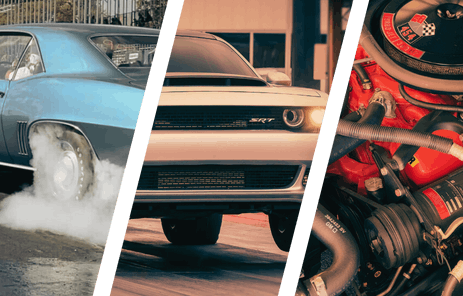Our list of Hot Rods You Should Know wouldn’t be complete without acknowledging the first hot rods of a kind, particularly in the racing world. That’s why this month, we’re taking a look at what many have dubbed the first belly tanker car ever built, the famous Bill Burke P-51 belly tanker.

At the time WWII started, salt and dry lake racing were popular pastimes for hot rodders, particularly those intrigued with the idea of going as fast as their built cars could possibly go. Bill Burke was one such rodder and began to make a name for himself in the land-speed racing scene before shipping off with the military to fight in the Second World War.
While the war certainly took Burke away from his beloved hot rods for awhile, the equipment he was working with while stationed in the South Pacific ultimately piqued his interest, giving him ideas about aerodynamics, speed and the sustainability of land-speed cars. Burke was particularly interested in the belly tanks from fighter planes.

Used to allow fighter pilots a larger range of flight by supplying the plane with more fuel, the belly tanks Burke saw showed the streamlining that could push dry lake race cars to a new level, something that rodder Bob Rufi had entertained prior to the war with the build of his race car with a similarly shaped body to the belly tank design. Seeing tanks that resembled the body of Rufi’s car, Burke came up with the thought of using discarded belly tanks and transforming them into race cars.
Once Burke returned home from the war, he put his ideas into action, obtaining the belly tank from a P-51 Mustang and creating the first ever “belly tank streamliner.” A new concept in the dry lake and salt flat racing worlds, Burke’s car, which was built out of a small 165-gallon steel wing tank, quickly gained attention. Unfortunately, the tank wasn’t quite big enough for Burke to build his car like he had seen Rufi do, putting the engine in the back of the vehicle with the driver up front. The result was a bit mismatched from what we know as belly tankers today, with the engine up front and nothing but a bicycle seat welded behind it for the driver to sit on.

In 1946, the year he debuted his new car, Burke raced his streamliner just three times, hitting a top speed of 131.96 mph. Though impressive for the new concept vehicle, the car’s fastest run just barely missed the record Burke was aiming for – Rufi’s 140.0mph record set before WWII.
With the original car lost over time, Geoffrey Hacker recreated Burke’s original belly tank car in a replica. This replica shows how small this belly tanker actually was.
Enjoy this video of the crew firing up the replica at Bonneville:
Learning a number of things from his first attempt at the belly tank streamliner game, Burke opted to build a different, much larger tanker car for the 1947 race season, this time partnering with Don Francisco on the build. For this tanker, the car was built using a Model T frame and a P-38 tank. The engine was placed behind the driver and the side of the car wore the number 16 on it, noting Burke’s 16th place standing from the previous race year (this build had a top speed run of 139.21 mph). This car became known as the “Sweet 16” car and is more well-known than the P-51 car.
What some people may not know is that the original No. 16 tanker was involved in a wreck and a third tanker was built from the few salvageable, and many new pieces, in just over a week’s time. The car that was known as the “Sweet 16” streamliner was actually Burke’s third streamliner he built.

It was this third belly tank car that raced in subsequent seasons, as well as appeared on the front cover of Hot Rod Magazine in August of 1949. At the time of its Hot Rod cover appearance, the car wore number 3 on its side for Burke’s third-place standing. This is the streamliner that people most famously associate with Burke and his build partner Francisco, as well as the tanker that was dubbed “the world’s fastest hot rod” after putting down a top speed run of 151.085 mph.
While Burke’s own streamliner solidified records on the dry lake beds, other Burke-built belly tank racers were brought into the mix. As it turns out, Burke built a handful of belly tank “rollers” for other people, who outfitted the cars with their own engines before racing them. One of these cars was the So-Cal Speed Shop streamliner and another was the record-setting car commissioned by Earl Evans.
In 1950, the “Lakester” class was created and almost explicitly catered to the belly tank cars, which prior to that point, had to race in the Streamliner category. It was with the introduction of the new Lakester class that more and more belly tank-style race cars entered the race field, and the rest is history!

You might also like
PRI 2025: Drop Valvetrain Weight Using PBM Titanium Valves
PBM enters the valve market with their titanium valves that reduce reciprocating weight, ensuring precise valve control.



